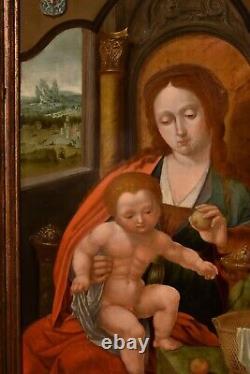Large Painting Antique Madonna Maestro Del Parrot Oil On Board 16/17 Century


















Large Painting Antique Madonna Maestro Del Parrot Oil On Board 16/17 Century. The description of this item has been automatically translated. Master of the Parrot' (Painter active in Antwerp in the early 16th century, whose name refers to the parrot that always recurs in his Marian paintings) - follower of.
Enthroned Madonna with Child (With the coat of arms of the commissioning family in the upper part of the composition). Oil on the table 101 x 62cm. In frame 114 x 76 cm.
Full details relating to this painting can also be viewed directly at the following - links. The beautiful proposed work displays the typical iconographic characteristics of the painter called'Master of the Parrot', a conventional name used by critics to define an anonymous Dutch author of the 16th century. More precisely, he is a painter from the southern Netherlands, active in Antwerp around 1530-50, so defined for the unmistakable parrot that often appears in his works.
In religious iconography, the parrot has often been used as a Marian symbol, as it was widely believed that its most common verse was "Ave", that is, the greeting of the Archangel Gabriel to Mary at the moment of the Annunciation. Today there is a widespread idea according to which the denomination'Parrot Master' does not refer to a single painter, but rather to a group who, on the basis of stylistic characteristics, carried out their training in the workshop of Pieter Coecke van Aelst (Aalst 1502 - Brussels 1550), creating devotional paintings intended for a bourgeois clientele and concentrating their activity on a specific topic particularly requested by the contemporary market. As an example we can mention the Virgin and Child of the San Diego Museum of Art links. Where the figures, like ours, are in line with the Mannerist taste for elegant bodily proportions that go beyond reality, with elements such as tapering fingers, a broad face and a thin nose. These characters also betray the influence of artists active in the region such as Joos van Cleve, Ambrosius Benson and Jan Gossaert, from whose works he must necessarily have taken his cue. As we can clearly see from our painting, executed by a talented follower commissioned by the family whose coat of arms is affixed in the upper part, the works of these artists were characterized by the unmistakable reception of Italian Renaissance painting, particularly visible in the way in which the child is on his mother's lap and still in the compositional choice of inserting a glimpse of the landscape visible through a window. Even the nuanced technique, reminiscent of Leonardo, attests to the lasting Italian influence in these works. The state of conservation of the panel is good, perfectly restored; there is a slight crack, visible in the lower part of the canvas in conjunction with the corner of the table, stabilized, and which minimally affects the reading of the work.It has an ancient professionally executed parquet. The painting is completed by a pleasant golden frame. It is our duty to inform you that, given the delicacy of some particular antique frames, there is the possibility that small damage to the gilding may occur during transport, despite the packaging being carried out with the utmost care. It is also possible to see the painting in the Riva del Garda gallery, we will be happy to welcome you to show you our collection of works.
As an example we can mention the Virgin and Child of the San Diego Museum of Art (links) where the figures, like ours, are in line with the Mannerist taste for elegant bodily proportions that go beyond reality, with elements such as tapering fingers, a broad face and a thin nose. As we can clearly see from our painting, executed by a talented follower commissioned by the family whose coat of arms is affixed in the upper part, the works of these artists were characterized by the unmistakable reception of Italian Renaissance painting, particularly visible in the way in which the child is on his mother's. Maestro del Pappagallo (Anversa, primi del XVI secolo), seguace.


